January 13, 2016
Hotels of America, by Rick Moody
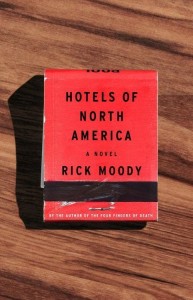 Reviewed by Kerry, Toronto Canada. Rated 3 out of 5 stars I bought a copy of Hotels of North America, by Rick Moody, because I was intrigued by the idea of a novel comprising online hotel reviews. I am not being facetious when I write that online hotel reviews are actually one of my favourite kinds of literature, and I have passed many an hour reading aloud ones written by English people, who tend to be very cranky and have strong feelings about the temperature of toast. And part of the reason I love these reviews so much is because of the narrative one senses beneath those few hundred words, the rage and fury that bubbles to the surface, the idea one gets of what the writer left behind as he embarked on his disappointing getaway. And the narrative, rather than the hotel amenities, is what Moody’s Morse—a prolific and popular reviewer—focuses on, the reviews themselves posted in alphabetical order but referring to hotel visits spread over decades of Morse’s curious and mysterious life (which has lately been particularly peripatetic). Usually the hotel itself merely serves as a platform for Morse launching into an episode from his past, involving his broken marriage, a troubling love affair, his itinerant work as a motivational speaker, the various schemes he’s embarked upon with his current partner, K. Some of these episodes are funny, and more than once I laughed out loud. A few are poignant, and each piece is a thoroughly worthwhile vignette. Cumulatively though, the novel lacked momentum—strange for a novel about travel, although the problem is that Morse never gets anywhere. So that I’d put the book down and not be compelled to pick it up again, though I was happy enough once I had done so. And while I am not sorry I read this book, and I’d recommend it to interested readers on the basis of Moody’s writing, I will probably not read it again. Was this review helpful?
Reviewed by Kerry, Toronto Canada. Rated 3 out of 5 stars I bought a copy of Hotels of North America, by Rick Moody, because I was intrigued by the idea of a novel comprising online hotel reviews. I am not being facetious when I write that online hotel reviews are actually one of my favourite kinds of literature, and I have passed many an hour reading aloud ones written by English people, who tend to be very cranky and have strong feelings about the temperature of toast. And part of the reason I love these reviews so much is because of the narrative one senses beneath those few hundred words, the rage and fury that bubbles to the surface, the idea one gets of what the writer left behind as he embarked on his disappointing getaway. And the narrative, rather than the hotel amenities, is what Moody’s Morse—a prolific and popular reviewer—focuses on, the reviews themselves posted in alphabetical order but referring to hotel visits spread over decades of Morse’s curious and mysterious life (which has lately been particularly peripatetic). Usually the hotel itself merely serves as a platform for Morse launching into an episode from his past, involving his broken marriage, a troubling love affair, his itinerant work as a motivational speaker, the various schemes he’s embarked upon with his current partner, K. Some of these episodes are funny, and more than once I laughed out loud. A few are poignant, and each piece is a thoroughly worthwhile vignette. Cumulatively though, the novel lacked momentum—strange for a novel about travel, although the problem is that Morse never gets anywhere. So that I’d put the book down and not be compelled to pick it up again, though I was happy enough once I had done so. And while I am not sorry I read this book, and I’d recommend it to interested readers on the basis of Moody’s writing, I will probably not read it again. Was this review helpful?
January 12, 2016
The Babysitters Club, or What Comes Down Through the Ages
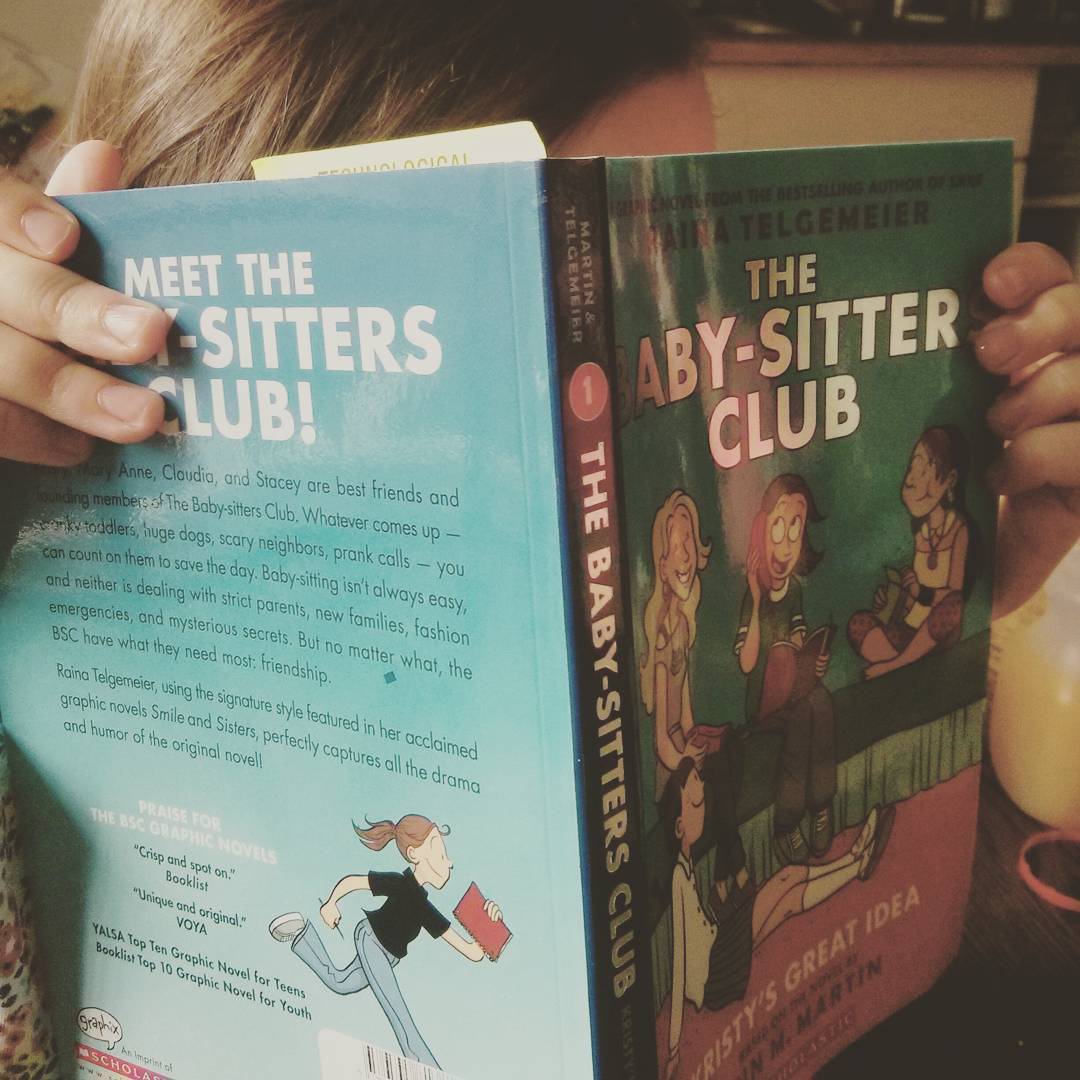
Whenever I start to worry too much about shaping my child’s cultural consciousness, I remind myself that at the age of ten I read The Babysitters Club series exclusively and that I once cried at receiving Swallows and Amazons for my birthday instead of Mallory and the Trouble With Twins. (Remembering this is why I try to read classic children’s books with my daughter, rather than expecting her to gravitate to them on her own.) I used to tick off BSC books in my Scholastic Book Order like they were going out of style, and refused to believe that they ever would go out of style. I remember a conversation with my mom about how it was a shame the books weren’t in hardcover because they fell apart in paperback and how was I ever going to pass them onto my own children the same way my mom had given me her Trixie Beldens and Cherry Ames. (I think had different ideas about hoarding then.) I recall my mom was skeptical about the books’ everlastingness.
It’s odd to realize that I was kind of right, however. The first book in Ann M. Martin’s iconic series (iconic, that is, if you were a certain kind of age in a certain type of place), Kristy’s Great Idea, was rereleased in 2006 in graphic novel form by the award-winning Raina Telgemeier, along with three other titles. Although it stayed peripheral to my experience until our friend Erin bought Harriet her own copy of Kristy’s Great Idea, and Harriet was hooked. She loved it. You can’t imagine how strange it is for your daughter to be telling you about how Kristy Thomas’s two brothers are called Sam and Charlie. That this kind of knowledge is the sort of thing that gets comes down through the ages. Who knew that The Babysitters Club would actually be a series of books that got passed on to my children?
 But it’s not really so surprising, when you think about it. There’s always been something generative about the series. The characters themselves are types, but also specific down to their accessories (or lack of them—not everyone can pull off dangly parrot earrings), and that the books were told from all their different points of view enabled readers to try on these roles for size. This is just a starting point for how readers have taken ownership of these familiar characters and their favourite books. These are characters who live beyond the page, as attested to by the popularity of Babysitters Club fan fiction communities online. The books have generated blogs including those revisiting the entire series and another exploring its characters’ tastes in fashion.The series are also Buzzfeed bait: note The Definitive Ranking of All 131 Babysitters Club Covers Outfits. Artist Kate Gavino designed a series of book covers imagining the series had it taken place in 2014. I recall a few years back someone was making notebooks out of recycled BSC book covers. Not to mention that the series was self-generating—so many spin-off series, so many…recycled notebooks. Plus board games, movies, dolls, etc. And the imitation babysitting clubs the books must have inspired as well—though I do wonder if any of these were successful. From an entrepreneurial point of view, it was not the greatest business model. As a parent it would be most inconvenient to only be able to schedule babysitters twice a week and if Kristy Thomas had been a proper capitalist, wouldn’t she have kept all the babysitting jobs for herself?
But it’s not really so surprising, when you think about it. There’s always been something generative about the series. The characters themselves are types, but also specific down to their accessories (or lack of them—not everyone can pull off dangly parrot earrings), and that the books were told from all their different points of view enabled readers to try on these roles for size. This is just a starting point for how readers have taken ownership of these familiar characters and their favourite books. These are characters who live beyond the page, as attested to by the popularity of Babysitters Club fan fiction communities online. The books have generated blogs including those revisiting the entire series and another exploring its characters’ tastes in fashion.The series are also Buzzfeed bait: note The Definitive Ranking of All 131 Babysitters Club Covers Outfits. Artist Kate Gavino designed a series of book covers imagining the series had it taken place in 2014. I recall a few years back someone was making notebooks out of recycled BSC book covers. Not to mention that the series was self-generating—so many spin-off series, so many…recycled notebooks. Plus board games, movies, dolls, etc. And the imitation babysitting clubs the books must have inspired as well—though I do wonder if any of these were successful. From an entrepreneurial point of view, it was not the greatest business model. As a parent it would be most inconvenient to only be able to schedule babysitters twice a week and if Kristy Thomas had been a proper capitalist, wouldn’t she have kept all the babysitting jobs for herself?
Anyway, it makes sense, with Martin’s wholly realized fictional world, that Telgemeier would have so much to work with in these stories, and that the graphic novels themselves would be so successful. The books are empowering and feminist (these girls may have worked as caregivers, but caregiving was their business; strong feminist role models, paging Kristy Thomas’s mother, anyone? [before she married a millionaire], and how about their author who lived seemingly single in New York City and hated to cook?), and, as I’ve made clear, most inspiring.
Perhaps we should be collecting them in hardback after all.
January 11, 2016
I think my spaceship knows which way to go…
https://www.youtube.com/watch?v=cYMCLz5PQVw
I am not a David Bowie fan. I’ve never bought any of his albums, I only know his most popular songs, and the only David Bowie song I knew for the first decade of my life was “Dancing in the Street” with Mick Jagger; my parents were more Elton John people. The first time I heard “Under Pressure,” I thought it was Vanilla Ice, and I was nearly 20. So I’ve got no cred whatsoever (if you ever thought I did), but I’d be hard-pressed to think of a musician I’m not a fan of whose work has affected me more. This morning we heard that he had died, and I put on “Modern Love” so we could have a dance party in the living room. I played “Let’s Dance” for my dance-loving girls tonight. I’ve been humming “Space Oddity” all day, hearing those amazing harmonies. There was a time in my when everything had fallen apart, and I spent that period listening to that song over and over again, those lines resonating: “The stars look very different today.” And learning to have faith in my own direction: “And my spaceship seems to know which way to go.” Understanding so much what it was to be lonely and lost—no one can be wholly alone whilst listening to that song. And more recently, his song “Kooks” has meant a lot to me, since Elizabeth Mitchell covered it on her album, Blue Clouds (which I love so much—it also features the most gorgeous cover of Van Morrison’s “Everyone.”) We listened to this album all the time when I was pregnant with Iris, and it might have become part of her sonic DNA. “Kooks” is a song about waiting for a baby, and hoping that baby will take its chances on you: “Will you stay in a lovers’ story, if you stay, you won’t be sorry, cuz we believe in you…” And it includes the line that really is my parenting philosophy, particularly in regards to school: “And if the homework brings you down/ Then we’ll throw it on the fire./And take the car downtown.” (Listen to Elizabeth Mitchell’s cover here.)
January 10, 2016
Birdie, by Tracey Lindberg

Last week writers Lee Maracle, Drew Hayden Taylor and Tracey Lindberg spoke on CBC’s The Current about the idea of First Nations book club month (responding to Minister of Indigenous and Northern Affairs Carolyn Bennett’s recent proposal) and what the experience is like being an Indigenous writer in Canada. The program was excellent, and the show was stolen by Maracle, who was indomitable, admirably cantankerous, and an excellent articulator of her situation and that of other First Nations women writers.
Maracle explained, “The balance in reading is not there for Indigenous women. 70% of book buyers are women, but 80% of books sold are men’s—it doesn’t matter what colour you are., So I think that’s a problem in Canada. If you just say Indigenous books, I think Tom King, Drew Taylor, Richard van Camp will get on the list [of suggested titles for a book club], and myself and Tracey will be at the bottom or at the middle.” The numbers back up her experience; in 13 years, for example, Canada Reads has never featured a book by a First Nations women writer—though I suspect this is a wrong that will begin to be righted upon the announcement of this year’s shortlist, which may very well include Tracey Lindberg’s Birdie. In fact, I hope it does.
Birdie is an example of what riches Canadian readers are missing when they’re overlooking First Nations women writers—a novel about women’s lives and experiences, the connections between them, and what happens when those connections are broken. (Think about more than 1000 missing or murdered women across this country—what must those absences be doing to families whose ties are already strained by centuries of colonial atrocities?) Though Birdie is most importantly about a particular woman, Bernice Meetoos, nicknamed Birdie, who has turned up in Gibsons, BC, after years of drifting, a pilgrimage to the place where The Beachcombers was filmed. In her bag, she carries decades-old clippings of Pat John, an actor from the show—”a healthy, working Indian man.” She’s preoccupied by thoughts of John, as well as taking guidance from The Frugal Gourmet, whose PBS cooking show is broadcast on the CBC. Things have not been quite right with Birdie, even more so than usual (and she spent four years living on the streets of Edmonton after all). She’s secured a job at a bakery and even has a place to live, a local woman to watch out for her—but then something breaks. She goes to bed, doesn’t eat, scarcely breathes, won’t be roused. And as ever when help and comfort are needed, it is the women who come.
First, Bernice’s cousin, Skinny Freda, the two of them raised like sisters, although the circumstances of Freda’s parentage are scarcely delineated. And then she sends for their Aunt Val, who’s had her own ups and downs, but is a motheraunt to both women as Birdie and Freda are sistercousins to each other (and such compound words abound throughout Birdie, suggesting that English proper is not up to the task of telling this story, just as the novel as we know it is inadequate to contain it, and therefore chronology is disrupted, notions of realism challenged, the whole book infused with elements of First Nations storytelling and mythology—Lindberg should be celebrated for her pushing the limits of what “the novel” can be). From her bed, in a kind of dream state, Bernice relives the traumas she’s endured, chief among them childhood sexual abuse by her uncles, which culminated in a terrible act of violence (justice?) that leaves her estranged from her family, alone. Until the women come.
Also present, if not physically, is Bernice’s mother Maggie, invoked in the novel’s prologue and epilogue, whose own problems make her not wholly responsible to what happened to her daughter. Bernice’s landlady too, while not Native, becomes part of this collective of women watching over Birdie, suggesting the possibility of womanhood as a connection that goes beyond culture; what happened to Birdie is particular to her situation, but there is a universality to women’s experience. There are so many things that every woman understands—and we see from being close to each character in this collective that each woman has her own tragedies that she carries within her,
Surprisingly, Birdie is not a heavy book, even with all the violence and tragedy. It’s as funny as it is sad, and more than that, it’s vibrant—powered by the voice of a woman who seemingly lies unconscious, which is kind of ironic, but there’s a lot going on inside Birdie’s mind, even as she’s got one half-opened eye on The Frugal Gourmet. As a character she’s rich and realized, and Lindberg never makes her a victim of her circumstances, her agency retained even in her lowest moments. Her very act of retreating into her mind, while passive from the outside, is a powerful gesture, and necessary for healing, for the possibility of a future.
January 8, 2016
All Year Round, by Emilie Leduc
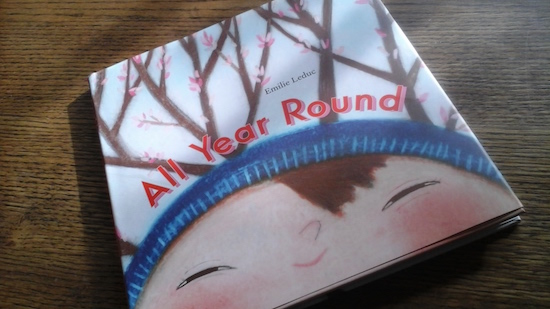
The new year is a perfect occasion to pick up All Year Round, written and illustrated by Emilie Leduc and translated from French by Shelley Tanaka. While it’s a truth universally known that there is no months-of-the-year book as perfect as Maurice Sendak’s Chicken Soup With Rice, it’s nice to also have another book that actually makes sense. Even if it fails to contain the line, “Whoopy once! Whoopy twice!”—my one criticism of this book. And most books, actually.
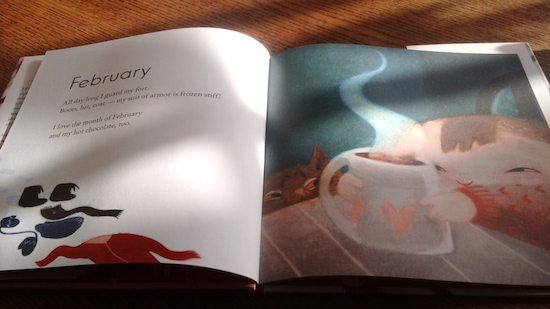
Each month includes a prose poem and beautiful celebratory illustration from a child’s point of view. Plus, a glimpse of a cat called Clementine, much to any young reader’s delight.
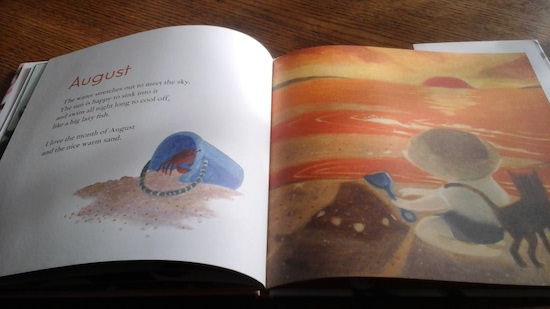
Every month and every season contains something wondrous, and that each month hinges on a non-secular occasion offers this book a perfect universality.
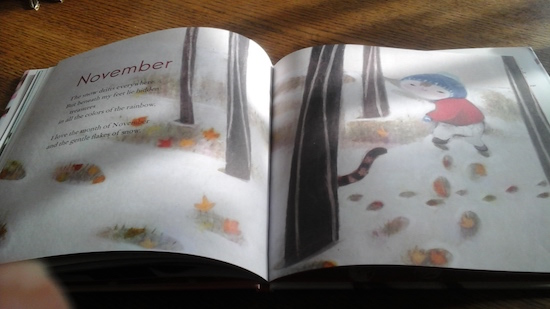
This book is a story about the rhythms of our world and of our lives—just as good as riding a crocodile down the chicken soupy Nile!
January 6, 2016
Today’s Teacup

I read this article by Globe and Mail reporter Janet McFarland years ago about children’s birthday parties gone wild and learning to take joy in small things. Her line about “an ‘ooh, doesn’t that look lovely’ contentment with a cup of tea or a few biscuits on a plate” (inspired by Bill Bryson’s thoughts on the English) has stayed with me ever since, and I’ve long made a point of trying note the smallest of ceremonies, the secret pleasures of the every day, even if sometimes it’s a ginger snap. I mean, as opposed to a chocolate digestive.
But I also have a sizeable collection of mugs and teacups, which I’m conflicted about. The teacups and their saucers less so because they’re delicate and lovely, and get pulled down and dusted off for special occasions. But yes, the mugs, because there’s really nothing sadder than a mug, stained, unwanted, abandoned in an office cupboard. The most depressing kind of gift—World’s Best Dad. I mean, I love mugs—some mugs. My mom gave me the most wonderful ceramic mug for my birthday, and it’s nearly replaced my Cath Kidston mug with the crack in it in terms of mugs of my heart. But then there are the mugs that slip on in to the back of the cupboard and all they’re doing is taking up space, and some of them are even wonderful—the Pyrex mug that Stuart found on the street and brought home because these are the mugs that remind me of summer, and the Miffy mugs we got in Japan, and my Diamond jubilee mug, and the mug with the M on it that my friend Jennie bought for me when we published The M Word. But what am I supposed to do with all these things?
I’ve been helped out of this philosophical quandary, however, with the help of Instagram. Because I am WILDLY SPONTANEOUS, I mixed up things mug-wise after receiving a gorgeous new orange mug from my friends Erin and Rebecca this weekend. This mixing only caused me a minimal amount of anxiety, until I realized that I could actually mix up mugs all the time (I know—crazy) and feature my eclectic mug/teacup collection on Instagram (because I’m in the posting-cups-of-tea population of Instragram users, as opposed to the taking-shots-of-myself-doing-yoga-on-a-beach crew). The trouble with mugs, I think, or at least the ones in the back of the cupboard, is that they serve no purpose, but they’ve been purposed now. Because #todaysteacup has been born.
Silly, frivolous, meaningless—but I don’t think so. It’s about the ceremony. About taking stock of the moment, the light, the cup of tea. It’s about using what you have, and having things that matter.
January 5, 2016
Lottie: Empowering Girls from Outer Space

We discovered Lottie Dolls over a year ago, and their premise intrigued me. A proper alternative to Barbie, designed to empower girls and their play. I wrote about them here (and check out the pictures! Iris was still a baby! Harriet was so little). It could have been a one-time thing, but I return to Lotties because now it’s my girls who are crazy about them. They’re the one toy, along with Legos, that gets returned to again and again, and they play with them together, which I love so much. We have five or six of them, and received more for Christmas, along with two new Lottie outfits, including the Superhero Lottie suit shown above, which has proven very popular—this is the one Lottie who never gets her clothes changed. When Harriet and Iris received Christmas money from their grandfather last week, they knew what they wanted to buy with it—more Lotties. And so we’re currently awaiting Rockabilly Lottie and Spring Celebration Ballet Lottie in the mail, expected delivery scheduled for tomorrow. Everybody is very excited.
Though we’ve also got our eye on Stargazer Lottie, who was sold out from Indigo.ca when we made our order last week. (Darn!). Like all the Lottie dolls, she’s designed around what she can do and be rather than how she looks (although admittedly, once they’re indoctrinated into Harriet’s play, the Lottie dolls also take on peculiar new identities…) I was so interested to read this post about how Stargazer Lottie was designed in consultation with an astronomer, and even more thrilled to learn that a Stargazer Lottie doll was currently in space with British astronaut Tim Peake on the International Space Station.
And most remarkable? That none of this would have happened at all without a six-year-old girl from Comox, British Columbia, who helped dream up the Stargazer Lottie doll. I showed the video below to Harriet who had her mind blown, and then went to put on her own dress with a space print and proceeded to have her head in the stars for the rest of the day, totally inspired.
January 4, 2016
Holiday Reading Joy

One day back into our routine, and I find I’m happy to be here. It’s been so long, with the sick-filled holidays and my three-plus weeks of pneumonia, and while I was nervous about this return to the real world, I find it much more pleasant and even more relaxing than where we’ve been lately. Although, granted, this is after just one day. Get back to me, perhaps, at the end of the week. But the one thing I do miss about the holiday was the reading—it was wonderful.
I was reading not-new and not-notable books in the weeks before Christmas, and enjoying the experience entirely. But then I picked up Niagara Falls All Over Again by Elizabeth McCracken, and found myself reading notably in spite of myself. It was so terrific. I’d adored McCracken’s short story collection, Thunderstruck, and I spent last Christmas Day sobbing while reading her exquisite memoir, An Exact Replica of a Figment of My Imagination. I read her The Giant’s House last summer, and liked it well enough, but it lacked the immediacy of her other books. And I had been reluctant to finally pick up Niagara Falls… because it was about men, a comedy team who find fame on the vaudeville circuit and in the golden days of Hollywood—nothing about that grabbed me. But the book did. Oh, its pacing, and energy, and to be so sad and so funny, and so completely realized. Truly, one of the best not-new books I read in 2015, and I’m so pleased that I finally did.
After that, I read Cassandra at the Wedding, which I bought at Ben McNally Books right before Christmas. I bought this one on the recommendation of Sarah from Edge of Evening, and was so pleased that I did. As Sarah writes, Dorothy Baker conjures Joan Didion in her setting but is entirely different in tone and approach—more wry than wrought, humour bubbling to the surface even in the darkest moments. It’s a book about twin sisters that seems like a great companion to Libby Crewman’s new novel, Split. About the connection between sisters and what happens when it’s severed, and how one person’s reality can be interpreted by another. Like so many books published by New York Review Books, Baker is doing fascinating things with narrative voice, and I appreciate how hearing from the slightly-deranged Cassandra’s sister Judith turns the whole story on its heel.
Then I read Inside Out, which is an essay by Rebecca Solnit with paintings by Stefan Kurtan. I’d asked for it for Christmas because I love Rebecca Solnit and wish to read everything she’s ever written, and also because it’s an essay on the subject of houses and homes, which I find really interesting. And it was. I loved her thoughts on materials and materialism, and the home as an extension of the female body while the automobile is that of the male (and therefore mobile), which connected to all kinds of things I’ve been thinking about Mad Men as we’re rewatching Season 1. Reading Rebecca Solnit is never not satisfying, and the book is beautiful.
I read Because of the Lockwoods next, by Dorothy Whipple. A Persephone Book, which is never short of extraordinary. I bought it in April when we were in London, because we’d been visiting Lancashire and she’s a Lancashire author and also because she is compared to Barbara Pym, similarly ripe for a revival, says Harriet Evans, but even a better writer. Whipple (whose unfashionable name is perhaps part of the reason she’s so fallen out of favour, writes Evans) is meant to be utterly readable, her novels absorbing. But I was dismayed to discover that they’re also 500 pages long, and you know how I feel about long books. It was one thing to carry such a doorstop across the sea, but then to actually pick it up and read it? Clearly I needed a holiday, a bit of space in which to make the long read happen—but then the book turned out to be everything Evans said. I read the whole thing in 2 days and now want to read everything in print by Dorothy Whipple. The novel was engaging, surprising, rich with complex characters and situations. I really loved it. Was dismayed to read that Virago Books was so thorough anti-Whipple. Thank goodness for Persephone for bring her back in print.
And then finally, I read The Magician’s Book: A Skeptic’s Adventures in Narnia, by Laura Miller, which was a marvellous celebration of reading, of literary criticism, and of the Narnia books and their creator, as well as critiquing the considerable problems with the two latter points. As we’re smack in the middle of reading the Narnia series (all of us for the first time!) in our family, I was glad to learn so much more about them and their context, and there was no shortage of fascinating Narnia and CS Lewis trivia, so that I become as uninteresting as I always do whilst reading excellent non-fiction (avidly sharing details, beginning every sentence with, “Did you know…) We’re reading Prince Caspian now, and I’m loving it all the more for Miller’s book.





